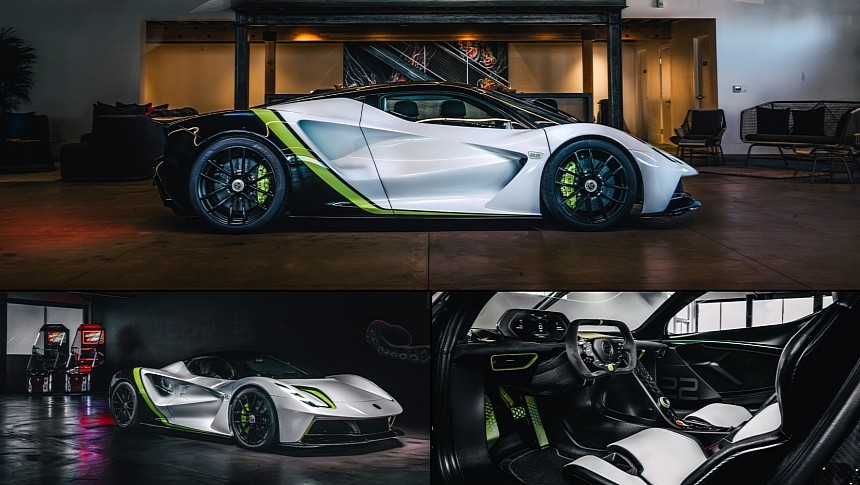Active in F1 between 2000 and 2017, the one and only Jenson Button secured his only drivers' championship in 2009 with an underdog team. Brawn GP competed on a tight budget, yet the team that would become Mercedes in 2010 secured both titles thanks to a technical regulations loophole.
The BGP 001 wasn't the only car on the grid with a double diffuser, though. But still, Brawn GP's aerodynamicists made the double-decker diffuser work more effectively than Williams and Toyota.
Currently involved in the NASCAR Cup Series on a part-time basis, Jenson Button paid tribute to the BGP 001 in the form of a Brawn GP-liveried hypercar. The zero-emission performance model is a bespoke commission that must have cost the Briton a pretty penny on top of the Lotus Evija's £1.7-million original starting price.
Original, as in the price advertised by the British automaker a whopping four years ago. Deliveries of the four-motor hypercar started this month, and given time, no fewer than 130 units will be manufactured.
1.7 million pounds sterling is 2,166,480 freedom eagles at current exchange rates, a mountain of cash that could alternatively get you a Rimac Nevera. Internally referred to as Type 130 and Omega, the Evija is named this way after variants of Eve. It supposedly means the first in existence, according to Lotus, which is most appropriate for the company's first-ever electric production model.
Jenson's white-painted Evija brings the point home with yellow and black accents. Most importantly, it further bears the number 22 on the housings of the side-view cameras. 22 was the number used on Button's racecar in the 2009 season, with teammate Rubens Barrichello running number 23. The Brazilian racing driver won twice that year, whereas Jenson won six Grands Prix.
Number 22 is prominently featured on the door cards, albeit in Arctic White as opposed to Verve Yellow for the exterior. Another special touch comes in the guise of a strip of aluminum, which runs vertically through the seat center. What makes it special? As it happens, the good folks at Lotus etched the date and location of all 15 Grand Prix victories from Jenson Button's Formula 1 career.
Beautified with perforated leather upholstery in white and black, an ebony headliner, and yellow contrast stitching, the Evija isn't only artwork on wheels. It packs the kind of performance that would make a casual motorist nauseous, for the Evija accelerates to 186 mph (300 kph) in just 9.1 seconds.
The four-motor Evija is officially rated at 1,500 kilowatts, which converts to 2,039 metric ponies or 2,012 horsepower. Torque is similarly impressive (1,704 Nm or 1,257 pound-feet), and the same can be said about the electronically-limited top speed (350 kph or 217 mph).
Currently involved in the NASCAR Cup Series on a part-time basis, Jenson Button paid tribute to the BGP 001 in the form of a Brawn GP-liveried hypercar. The zero-emission performance model is a bespoke commission that must have cost the Briton a pretty penny on top of the Lotus Evija's £1.7-million original starting price.
Original, as in the price advertised by the British automaker a whopping four years ago. Deliveries of the four-motor hypercar started this month, and given time, no fewer than 130 units will be manufactured.
1.7 million pounds sterling is 2,166,480 freedom eagles at current exchange rates, a mountain of cash that could alternatively get you a Rimac Nevera. Internally referred to as Type 130 and Omega, the Evija is named this way after variants of Eve. It supposedly means the first in existence, according to Lotus, which is most appropriate for the company's first-ever electric production model.
Jenson's white-painted Evija brings the point home with yellow and black accents. Most importantly, it further bears the number 22 on the housings of the side-view cameras. 22 was the number used on Button's racecar in the 2009 season, with teammate Rubens Barrichello running number 23. The Brazilian racing driver won twice that year, whereas Jenson won six Grands Prix.
Number 22 is prominently featured on the door cards, albeit in Arctic White as opposed to Verve Yellow for the exterior. Another special touch comes in the guise of a strip of aluminum, which runs vertically through the seat center. What makes it special? As it happens, the good folks at Lotus etched the date and location of all 15 Grand Prix victories from Jenson Button's Formula 1 career.
Beautified with perforated leather upholstery in white and black, an ebony headliner, and yellow contrast stitching, the Evija isn't only artwork on wheels. It packs the kind of performance that would make a casual motorist nauseous, for the Evija accelerates to 186 mph (300 kph) in just 9.1 seconds.
The four-motor Evija is officially rated at 1,500 kilowatts, which converts to 2,039 metric ponies or 2,012 horsepower. Torque is similarly impressive (1,704 Nm or 1,257 pound-feet), and the same can be said about the electronically-limited top speed (350 kph or 217 mph).
Here she is! Proud to show off my @lotuscars Evija which I think looks stunning???? if you are at Quail tomorrow you’ll be able to see her on the Lotus stand along with some other beautiful cars.
— Jenson Button (@JensonButton) August 17, 2023
What do you think of the Brawn inspired paint scheme? #lotus #evija #ev #hypercar… pic.twitter.com/fmWYU1bKm6







